COMM-171: Examining the Impact of Sweatshops on Women and Children
VerifiedAdded on 2023/06/09
|7
|1194
|156
Essay
AI Summary
This essay critically examines the argument that sweatshops can be a positive experience for women and children. It presents three main points to refute this claim: the factors that drive women and children to work in sweatshops, the negative implications of low wages and poor working conditions, and the regulatory measures taken to address these issues. The essay highlights the exploitation of workers, the denial of their rights, and the long-term physical and psychological damage caused by sweatshop labor. It also discusses the role of government regulations and corporate responsibility in improving working conditions and ensuring fair treatment of workers. The conclusion emphasizes the need for a holistic approach to eliminate child labor and improve the lives of those working in sweatshops. Desklib provides a platform for students to access similar essays and study resources.
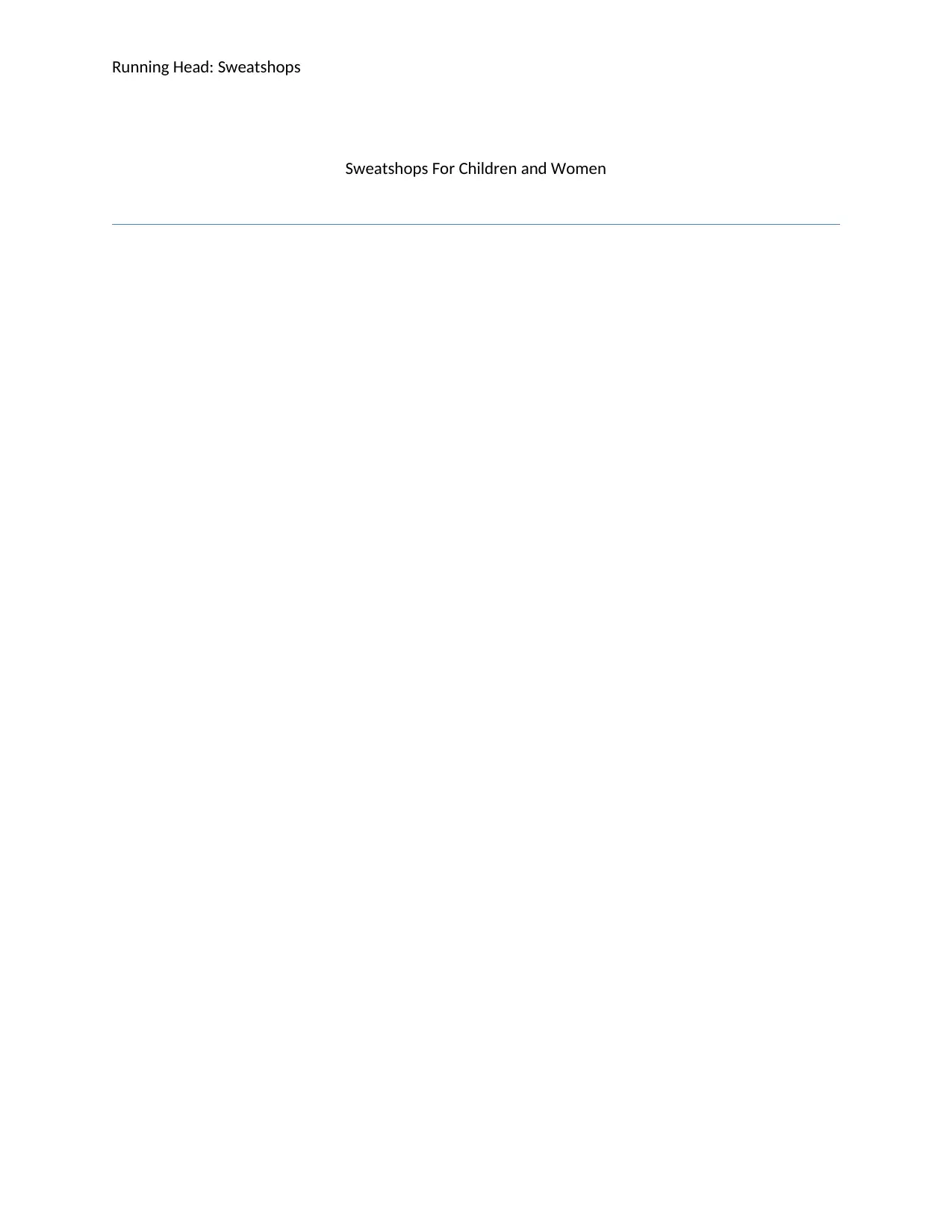
Running Head: Sweatshops
Sweatshops For Children and Women
Sweatshops For Children and Women
Paraphrase This Document
Need a fresh take? Get an instant paraphrase of this document with our AI Paraphraser
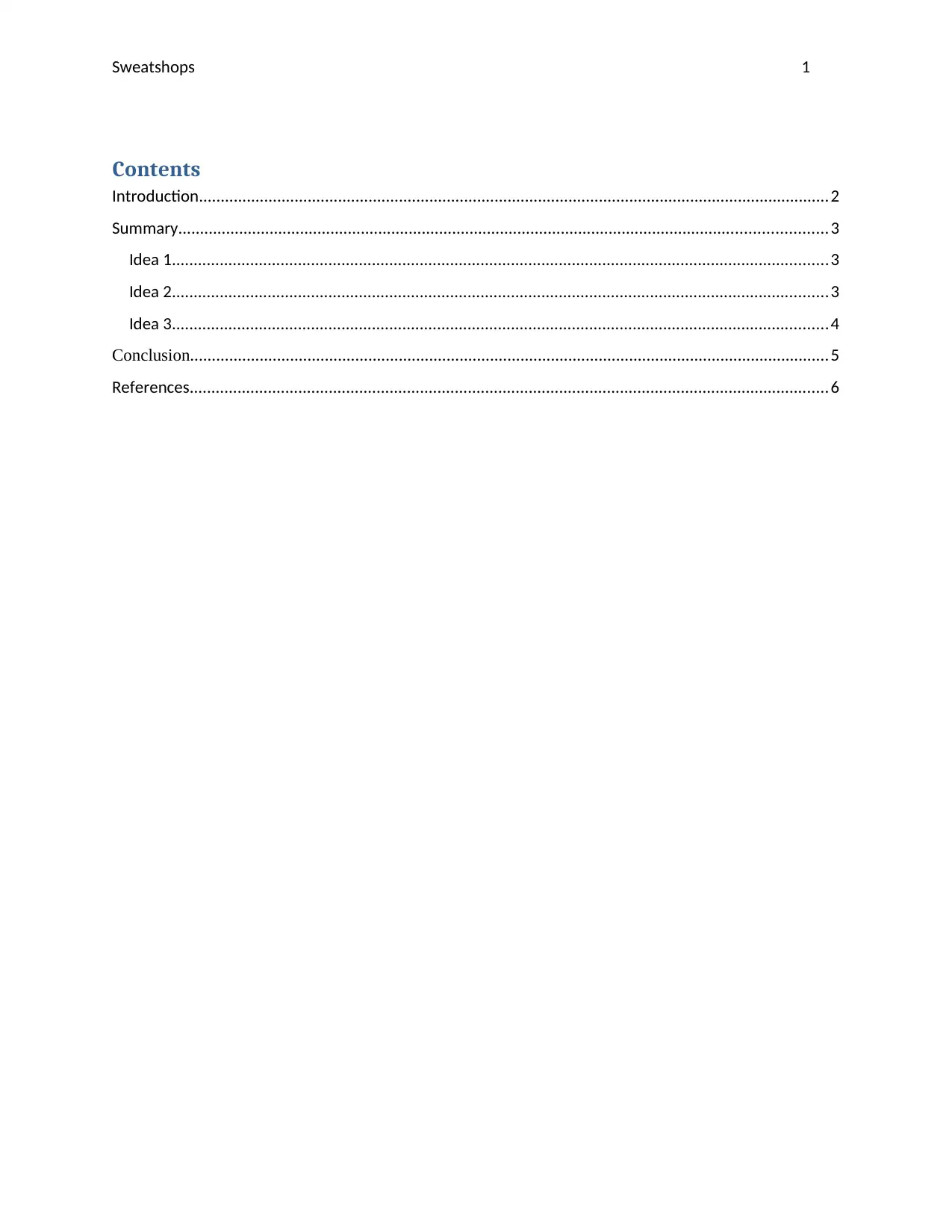
Sweatshops 1
Contents
Introduction.................................................................................................................................................2
Summary.....................................................................................................................................................3
Idea 1.......................................................................................................................................................3
Idea 2.......................................................................................................................................................3
Idea 3.......................................................................................................................................................4
Conclusion...................................................................................................................................................5
References...................................................................................................................................................6
Contents
Introduction.................................................................................................................................................2
Summary.....................................................................................................................................................3
Idea 1.......................................................................................................................................................3
Idea 2.......................................................................................................................................................3
Idea 3.......................................................................................................................................................4
Conclusion...................................................................................................................................................5
References...................................................................................................................................................6
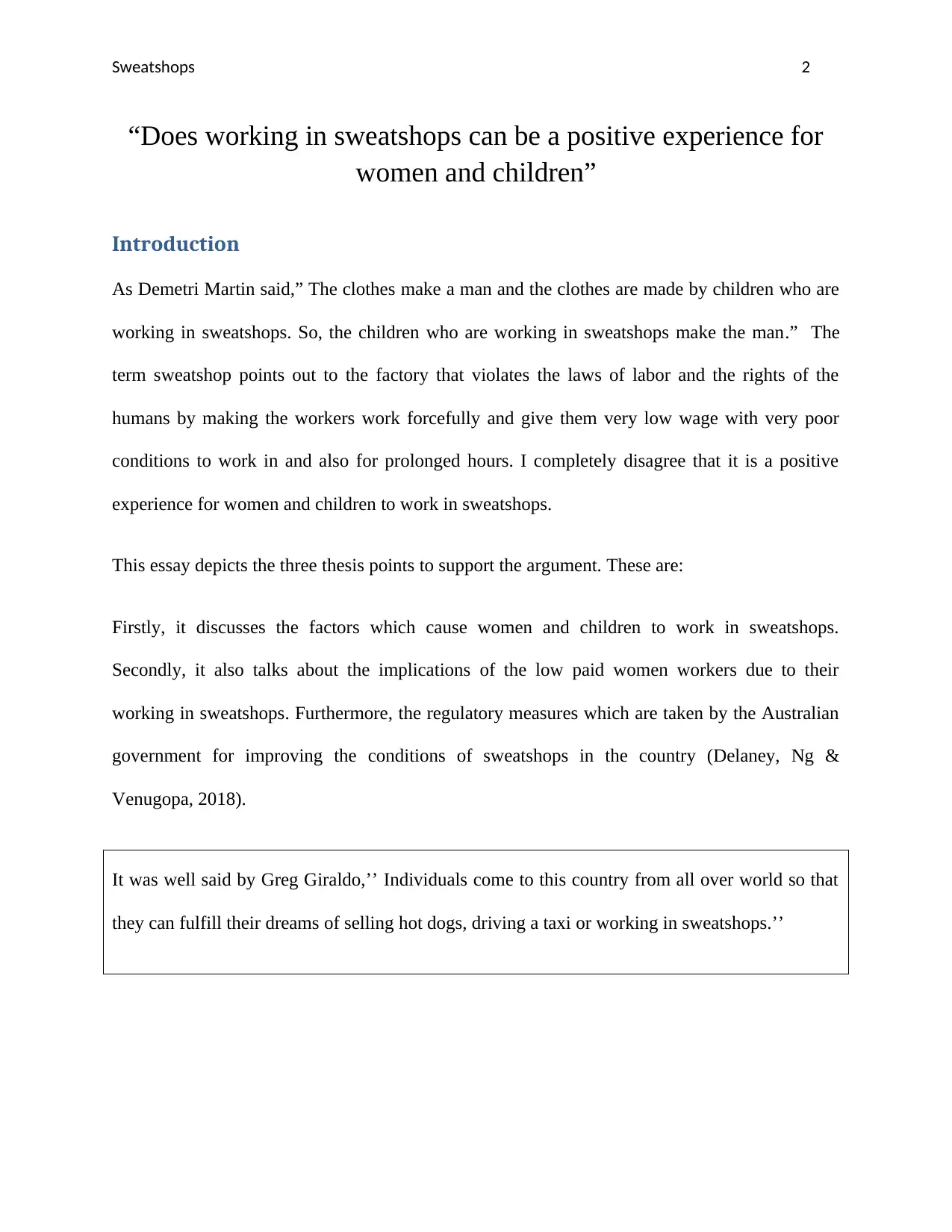
Sweatshops 2
“Does working in sweatshops can be a positive experience for
women and children”
Introduction
As Demetri Martin said,” The clothes make a man and the clothes are made by children who are
working in sweatshops. So, the children who are working in sweatshops make the man.” The
term sweatshop points out to the factory that violates the laws of labor and the rights of the
humans by making the workers work forcefully and give them very low wage with very poor
conditions to work in and also for prolonged hours. I completely disagree that it is a positive
experience for women and children to work in sweatshops.
This essay depicts the three thesis points to support the argument. These are:
Firstly, it discusses the factors which cause women and children to work in sweatshops.
Secondly, it also talks about the implications of the low paid women workers due to their
working in sweatshops. Furthermore, the regulatory measures which are taken by the Australian
government for improving the conditions of sweatshops in the country (Delaney, Ng &
Venugopa, 2018).
It was well said by Greg Giraldo,’’ Individuals come to this country from all over world so that
they can fulfill their dreams of selling hot dogs, driving a taxi or working in sweatshops.’’
“Does working in sweatshops can be a positive experience for
women and children”
Introduction
As Demetri Martin said,” The clothes make a man and the clothes are made by children who are
working in sweatshops. So, the children who are working in sweatshops make the man.” The
term sweatshop points out to the factory that violates the laws of labor and the rights of the
humans by making the workers work forcefully and give them very low wage with very poor
conditions to work in and also for prolonged hours. I completely disagree that it is a positive
experience for women and children to work in sweatshops.
This essay depicts the three thesis points to support the argument. These are:
Firstly, it discusses the factors which cause women and children to work in sweatshops.
Secondly, it also talks about the implications of the low paid women workers due to their
working in sweatshops. Furthermore, the regulatory measures which are taken by the Australian
government for improving the conditions of sweatshops in the country (Delaney, Ng &
Venugopa, 2018).
It was well said by Greg Giraldo,’’ Individuals come to this country from all over world so that
they can fulfill their dreams of selling hot dogs, driving a taxi or working in sweatshops.’’
⊘ This is a preview!⊘
Do you want full access?
Subscribe today to unlock all pages.

Trusted by 1+ million students worldwide
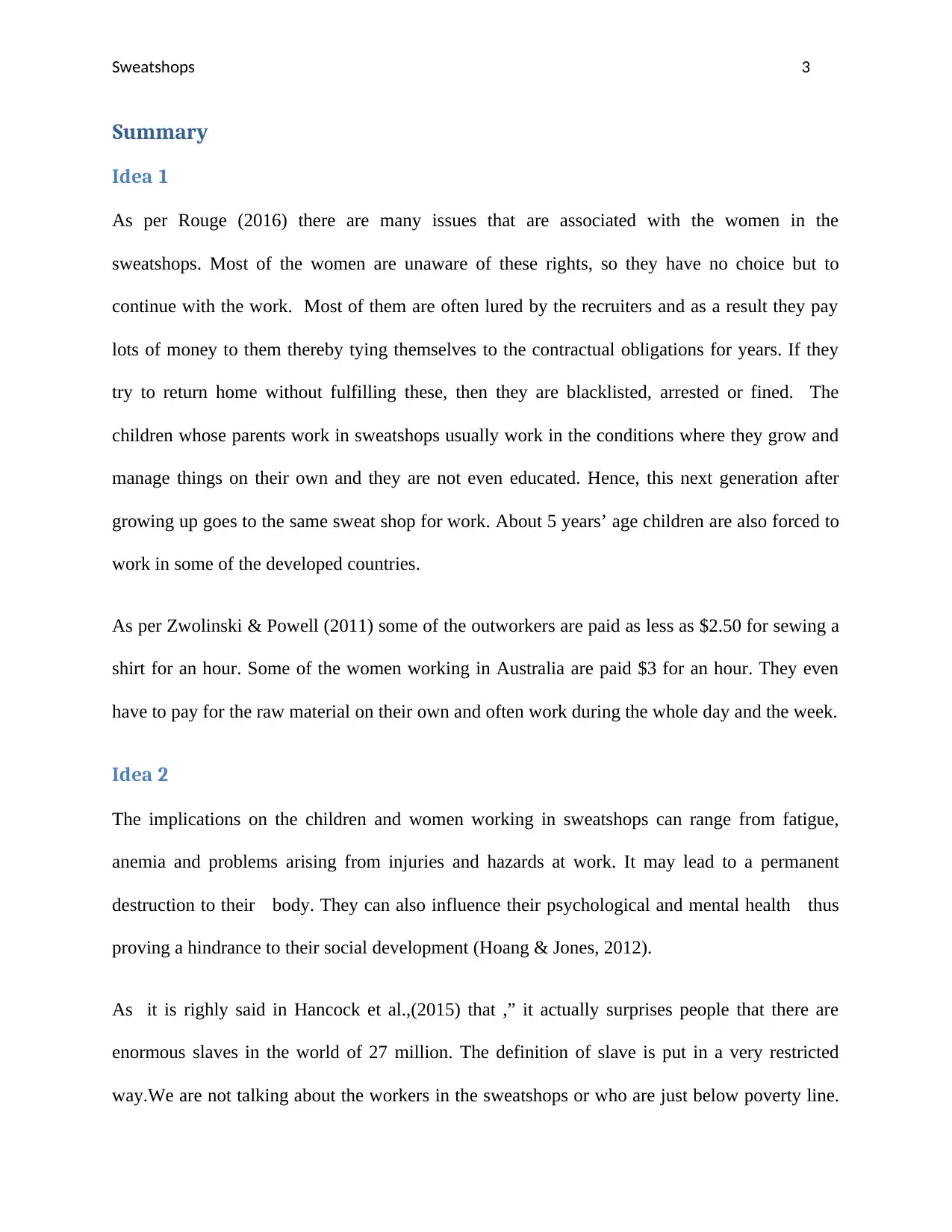
Sweatshops 3
Summary
Idea 1
As per Rouge (2016) there are many issues that are associated with the women in the
sweatshops. Most of the women are unaware of these rights, so they have no choice but to
continue with the work. Most of them are often lured by the recruiters and as a result they pay
lots of money to them thereby tying themselves to the contractual obligations for years. If they
try to return home without fulfilling these, then they are blacklisted, arrested or fined. The
children whose parents work in sweatshops usually work in the conditions where they grow and
manage things on their own and they are not even educated. Hence, this next generation after
growing up goes to the same sweat shop for work. About 5 years’ age children are also forced to
work in some of the developed countries.
As per Zwolinski & Powell (2011) some of the outworkers are paid as less as $2.50 for sewing a
shirt for an hour. Some of the women working in Australia are paid $3 for an hour. They even
have to pay for the raw material on their own and often work during the whole day and the week.
Idea 2
The implications on the children and women working in sweatshops can range from fatigue,
anemia and problems arising from injuries and hazards at work. It may lead to a permanent
destruction to their body. They can also influence their psychological and mental health thus
proving a hindrance to their social development (Hoang & Jones, 2012).
As it is righly said in Hancock et al.,(2015) that ,” it actually surprises people that there are
enormous slaves in the world of 27 million. The definition of slave is put in a very restricted
way.We are not talking about the workers in the sweatshops or who are just below poverty line.
Summary
Idea 1
As per Rouge (2016) there are many issues that are associated with the women in the
sweatshops. Most of the women are unaware of these rights, so they have no choice but to
continue with the work. Most of them are often lured by the recruiters and as a result they pay
lots of money to them thereby tying themselves to the contractual obligations for years. If they
try to return home without fulfilling these, then they are blacklisted, arrested or fined. The
children whose parents work in sweatshops usually work in the conditions where they grow and
manage things on their own and they are not even educated. Hence, this next generation after
growing up goes to the same sweat shop for work. About 5 years’ age children are also forced to
work in some of the developed countries.
As per Zwolinski & Powell (2011) some of the outworkers are paid as less as $2.50 for sewing a
shirt for an hour. Some of the women working in Australia are paid $3 for an hour. They even
have to pay for the raw material on their own and often work during the whole day and the week.
Idea 2
The implications on the children and women working in sweatshops can range from fatigue,
anemia and problems arising from injuries and hazards at work. It may lead to a permanent
destruction to their body. They can also influence their psychological and mental health thus
proving a hindrance to their social development (Hoang & Jones, 2012).
As it is righly said in Hancock et al.,(2015) that ,” it actually surprises people that there are
enormous slaves in the world of 27 million. The definition of slave is put in a very restricted
way.We are not talking about the workers in the sweatshops or who are just below poverty line.
Paraphrase This Document
Need a fresh take? Get an instant paraphrase of this document with our AI Paraphraser
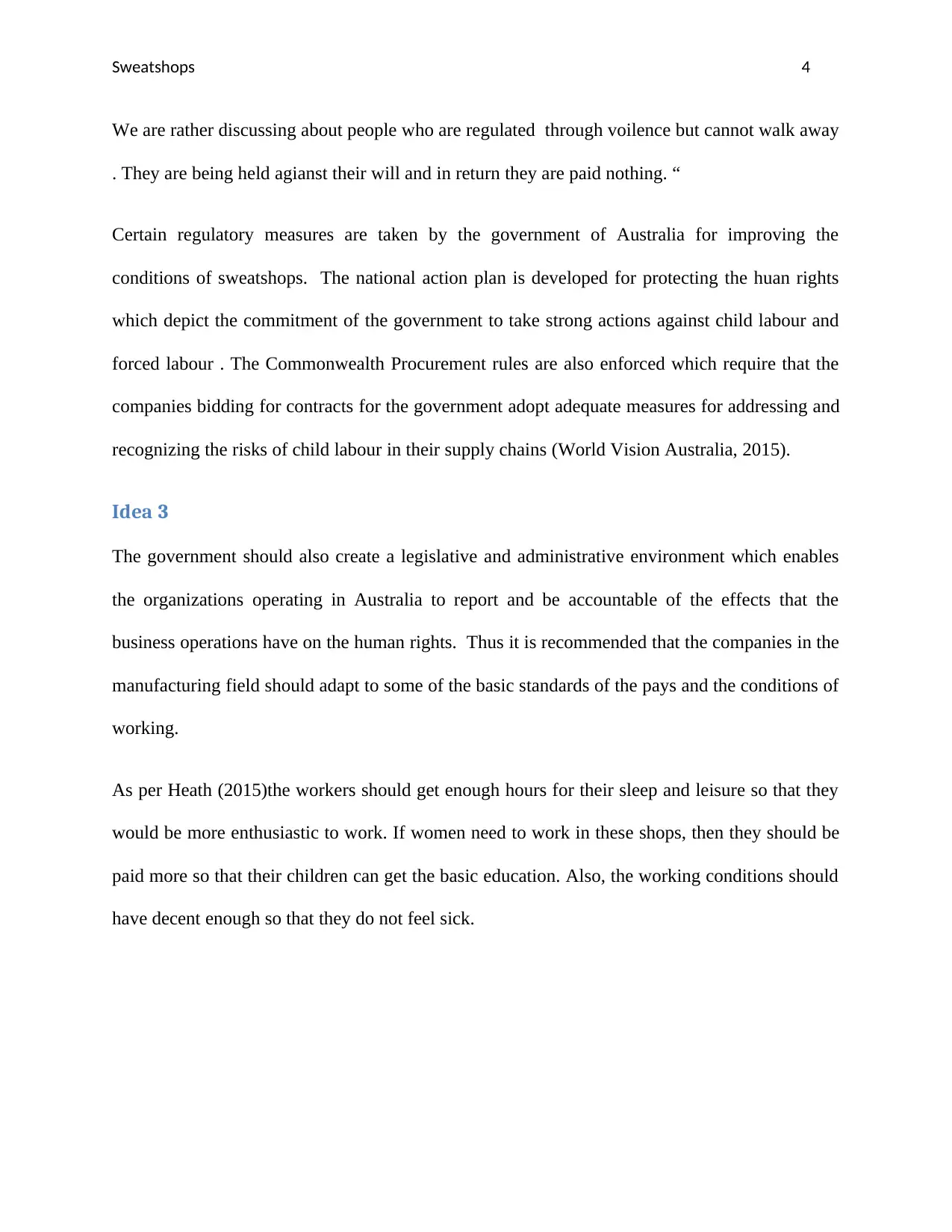
Sweatshops 4
We are rather discussing about people who are regulated through voilence but cannot walk away
. They are being held agianst their will and in return they are paid nothing. “
Certain regulatory measures are taken by the government of Australia for improving the
conditions of sweatshops. The national action plan is developed for protecting the huan rights
which depict the commitment of the government to take strong actions against child labour and
forced labour . The Commonwealth Procurement rules are also enforced which require that the
companies bidding for contracts for the government adopt adequate measures for addressing and
recognizing the risks of child labour in their supply chains (World Vision Australia, 2015).
Idea 3
The government should also create a legislative and administrative environment which enables
the organizations operating in Australia to report and be accountable of the effects that the
business operations have on the human rights. Thus it is recommended that the companies in the
manufacturing field should adapt to some of the basic standards of the pays and the conditions of
working.
As per Heath (2015)the workers should get enough hours for their sleep and leisure so that they
would be more enthusiastic to work. If women need to work in these shops, then they should be
paid more so that their children can get the basic education. Also, the working conditions should
have decent enough so that they do not feel sick.
We are rather discussing about people who are regulated through voilence but cannot walk away
. They are being held agianst their will and in return they are paid nothing. “
Certain regulatory measures are taken by the government of Australia for improving the
conditions of sweatshops. The national action plan is developed for protecting the huan rights
which depict the commitment of the government to take strong actions against child labour and
forced labour . The Commonwealth Procurement rules are also enforced which require that the
companies bidding for contracts for the government adopt adequate measures for addressing and
recognizing the risks of child labour in their supply chains (World Vision Australia, 2015).
Idea 3
The government should also create a legislative and administrative environment which enables
the organizations operating in Australia to report and be accountable of the effects that the
business operations have on the human rights. Thus it is recommended that the companies in the
manufacturing field should adapt to some of the basic standards of the pays and the conditions of
working.
As per Heath (2015)the workers should get enough hours for their sleep and leisure so that they
would be more enthusiastic to work. If women need to work in these shops, then they should be
paid more so that their children can get the basic education. Also, the working conditions should
have decent enough so that they do not feel sick.
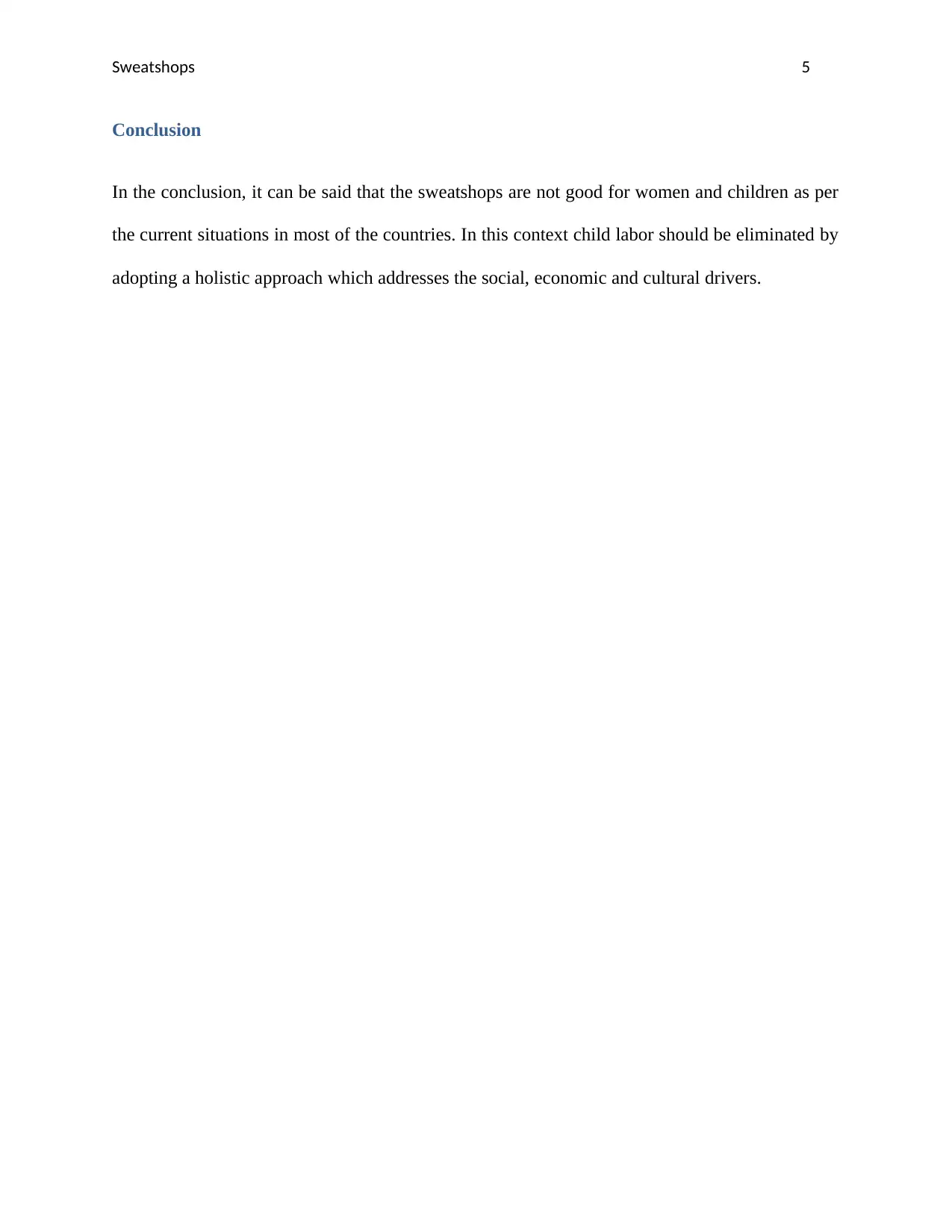
Sweatshops 5
Conclusion
In the conclusion, it can be said that the sweatshops are not good for women and children as per
the current situations in most of the countries. In this context child labor should be eliminated by
adopting a holistic approach which addresses the social, economic and cultural drivers.
Conclusion
In the conclusion, it can be said that the sweatshops are not good for women and children as per
the current situations in most of the countries. In this context child labor should be eliminated by
adopting a holistic approach which addresses the social, economic and cultural drivers.
⊘ This is a preview!⊘
Do you want full access?
Subscribe today to unlock all pages.

Trusted by 1+ million students worldwide
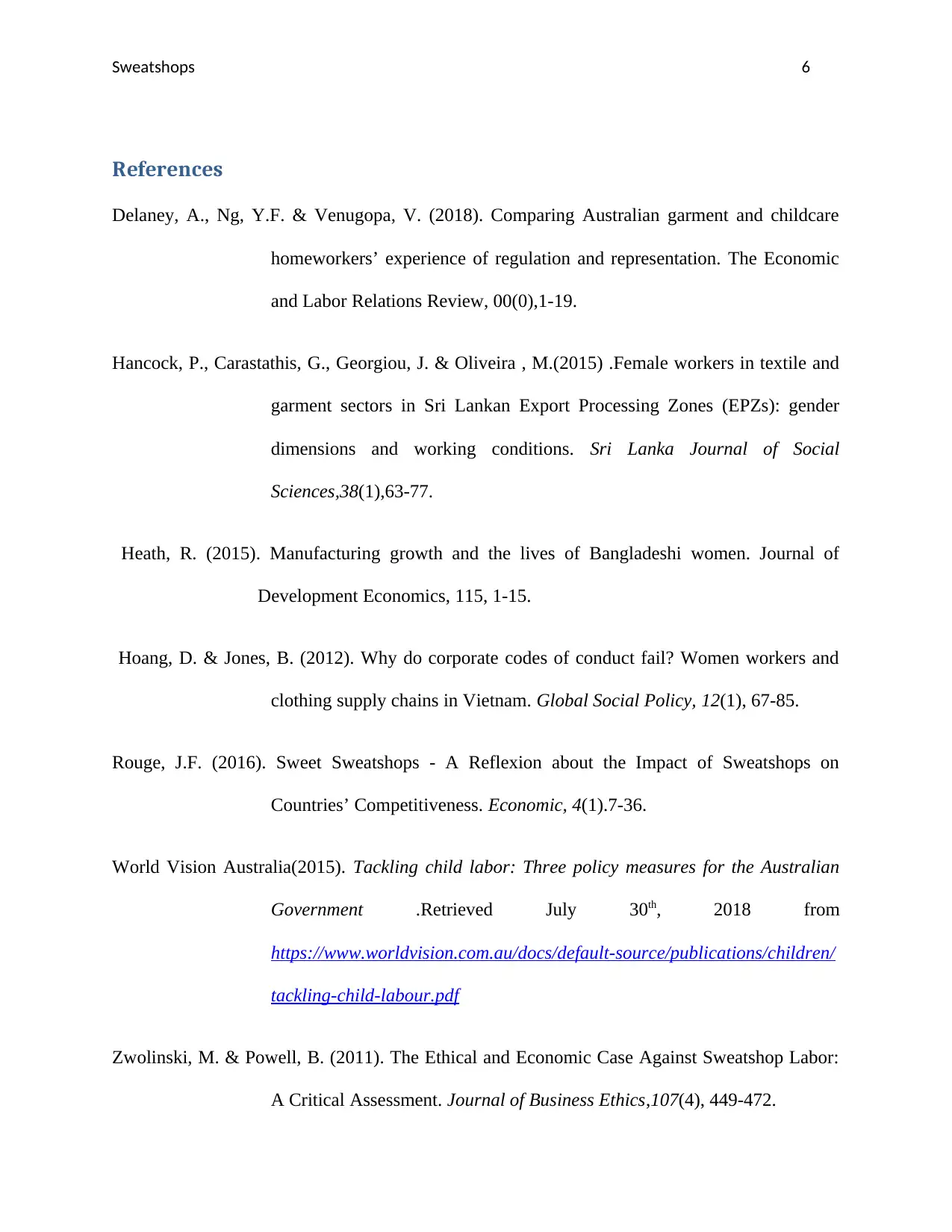
Sweatshops 6
References
Delaney, A., Ng, Y.F. & Venugopa, V. (2018). Comparing Australian garment and childcare
homeworkers’ experience of regulation and representation. The Economic
and Labor Relations Review, 00(0),1-19.
Hancock, P., Carastathis, G., Georgiou, J. & Oliveira , M.(2015) .Female workers in textile and
garment sectors in Sri Lankan Export Processing Zones (EPZs): gender
dimensions and working conditions. Sri Lanka Journal of Social
Sciences,38(1),63-77.
Heath, R. (2015). Manufacturing growth and the lives of Bangladeshi women. Journal of
Development Economics, 115, 1-15.
Hoang, D. & Jones, B. (2012). Why do corporate codes of conduct fail? Women workers and
clothing supply chains in Vietnam. Global Social Policy, 12(1), 67-85.
Rouge, J.F. (2016). Sweet Sweatshops - A Reflexion about the Impact of Sweatshops on
Countries’ Competitiveness. Economic, 4(1).7-36.
World Vision Australia(2015). Tackling child labor: Three policy measures for the Australian
Government .Retrieved July 30th, 2018 from
https://www.worldvision.com.au/docs/default-source/publications/children/
tackling-child-labour.pdf
Zwolinski, M. & Powell, B. (2011). The Ethical and Economic Case Against Sweatshop Labor:
A Critical Assessment. Journal of Business Ethics,107(4), 449-472.
References
Delaney, A., Ng, Y.F. & Venugopa, V. (2018). Comparing Australian garment and childcare
homeworkers’ experience of regulation and representation. The Economic
and Labor Relations Review, 00(0),1-19.
Hancock, P., Carastathis, G., Georgiou, J. & Oliveira , M.(2015) .Female workers in textile and
garment sectors in Sri Lankan Export Processing Zones (EPZs): gender
dimensions and working conditions. Sri Lanka Journal of Social
Sciences,38(1),63-77.
Heath, R. (2015). Manufacturing growth and the lives of Bangladeshi women. Journal of
Development Economics, 115, 1-15.
Hoang, D. & Jones, B. (2012). Why do corporate codes of conduct fail? Women workers and
clothing supply chains in Vietnam. Global Social Policy, 12(1), 67-85.
Rouge, J.F. (2016). Sweet Sweatshops - A Reflexion about the Impact of Sweatshops on
Countries’ Competitiveness. Economic, 4(1).7-36.
World Vision Australia(2015). Tackling child labor: Three policy measures for the Australian
Government .Retrieved July 30th, 2018 from
https://www.worldvision.com.au/docs/default-source/publications/children/
tackling-child-labour.pdf
Zwolinski, M. & Powell, B. (2011). The Ethical and Economic Case Against Sweatshop Labor:
A Critical Assessment. Journal of Business Ethics,107(4), 449-472.
1 out of 7
Related Documents
Your All-in-One AI-Powered Toolkit for Academic Success.
+13062052269
info@desklib.com
Available 24*7 on WhatsApp / Email
![[object Object]](/_next/static/media/star-bottom.7253800d.svg)
Unlock your academic potential
Copyright © 2020–2025 A2Z Services. All Rights Reserved. Developed and managed by ZUCOL.





